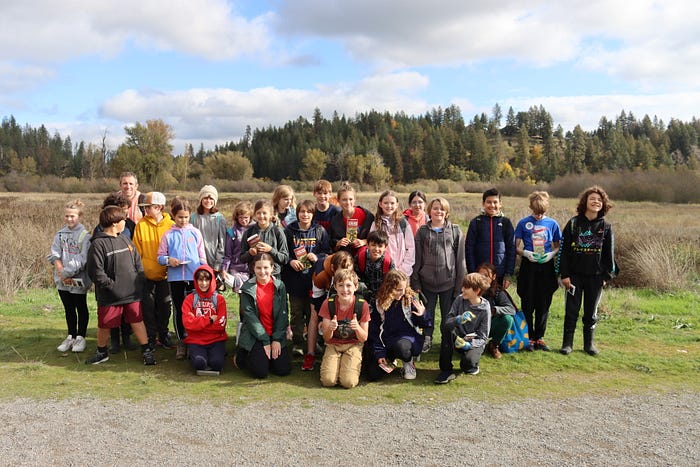Hands-on learning
Students take a break from books to improve wildlife habitat
The “wild” life at a Spokane area natural area recently included about 30 excited sixth graders armed with cutting utensils. The children, from St. George’s School in north Spokane, took their lessons outside for a day to learn about ecosystems, habitat restoration, trees and how they reproduce, and perform some community service at the same time.


St. George’s is very close to the Waikiki Spring Nature Preserve, a 95 acre natural area along the Little Spokane River that is managed by the Inland Northwest Land Conservancy (INLC) and adjacent to, as well as accessible through, WDFW’s Waikiki Springs Wildlife Area unit. Working together, WDFW and INLC manage and maintain this land, a total of 210 acres between the two agencies, for members of the public to use for everything from hiking and kayaking to fishing, dog walking, bicycling, cross country skiing, and snowshoeing.
This gem of an area, hidden in the middle of densely populated neighborhoods, not only has a spring that provides millions of gallons of water, but also 1,700 feet of shoreline along the Little Spokane River. It has pine forest, meadows, and ponds that make it ideal habitat for native fish and other wildlife. And at one time, it was for sale and there were plans for residential development. Fortunately, WDFW and INLC were able to purchase and preserve the land.
Both WDFW and INWC have extensive management plans for their sections of Waikiki Springs, with plans to restore areas damaged by overuse prior to being purchased. With limited staff though, it can be difficult to get the physical work done sometimes. Enter St. George’s staff. Teachers at the school are encouraged to find both outdoor and community projects to enrich students’ learning, so when 6th grade teacher Brad Kirsch reached out to INWC’s Stewardship Assistant Steven Eddington, they were both pleased to learn they could help each other.

Eddington organized a literal “field” trip for the kids to hike through the area, then he put them to work cutting willow live stakes. Live stakes are tree branches that are cut and then planted directly in the soil. These branches are able to develop roots and grow into new trees.



The kids spent several hours cutting and bundling the branches. Eddington stored them in water and members of the public showed up the following weekend to plant them during a special INWC planting event aimed at restoring natural habitat to areas of the preserve that could benefit from it.
Beyond completing the first phase of the public planting event- gathering the starts to plant- the students learned about the ethics of plant collection, what trees can be “cloned” in this fashion, how to properly carry tools and use them, and how to work in teams to accomplish a goal.
In the video below, Eddington talks about the invasive plants at Waikiki that made these students’ work such a valuable contribution, as well as why it’s important to get young people involved in projects like this.
At the end of the day, there was a large pile of bundled branches awaiting planting and a sense of accomplishment. And with the long hike back to the awaiting bus, hopefully some energy burned off to give their teachers a break.

INLC hosts planting events throughout the year. If you would like to help with this work to restore habitat on public lands, go to https://inlandnwland.org/ for more information.
